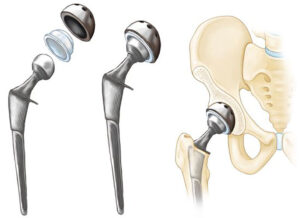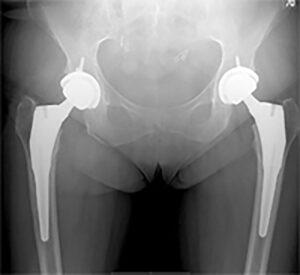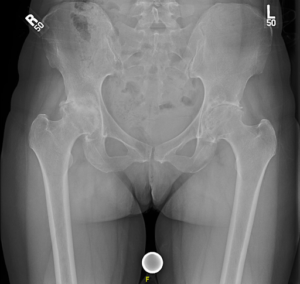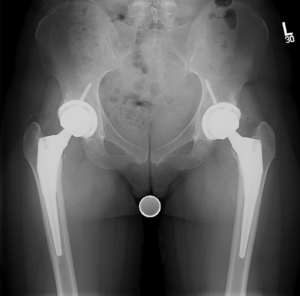The primary reason for joint replacement is the degeneration of all or part of a joint. Whether the degeneration is the result of an earlier accident or gradual wear and tear over the course of our life, this condition known as arthritis is ultimately the end result. Joint replacement can restore normal function and improve quality of life.
What is hip arthritis?
Arthritis literally means “joint inflammation,” and the hip joint is one of the most commonly affected joints in the body.
There are multiple causes of arthritis, but most arthritis is known as osteoarthritis, a relatively common degenerative condition. While some may have a genetic predisposition, the condition can be worsened with heavy activity, excessive body weight, and previous injuries to the joint. Other causes of hip arthritis include generalized inflammatory conditions, such as rheumatoid arthritis and related syndromes.
Patients with hip arthritis experience pain, most commonly in the groin or thigh, but that may also occur at the outside (lateral) part of the hip – and occasionally in the buttock. Unfortunately, the pain can be severe and progressive, usually requiring surgery. A normal hip x-ray, shown below, reveals the thigh bone (femur) with the femoral head (ball) and the pelvic bone, the acetabulum (socket). Notice that there is a space between the bones. In a healthy hip, this space is where the articular cartilage is located. On an x-ray, space between the bones is a good sign.
When arthritis becomes severe, the articular cartilage is worn away, the space between the bone narrows, and eventually this leads to “bone-on-bone” contact, which can be very painful.
A less common condition that also compromises the health and stability of the hip is avascular necrosis. This condition represents the death of bone tissue resulting from a loss of blood supply to the area.
What is a hip replacement?
A hip replacement involves the placement of prosthetic (artificial) hip implants into the bones to re-establish a smooth junction between the bones. A complete replacement of the joint with prosthetic implants is known as a Total Hip Replacement (THR) or Total Hip Arthroplasty (THA).
There are several different types of artificial joint surfaces, which your doctor will discuss with you. Most prosthetic parts are tightly fit into the bones. The bones naturally grow into the metal parts (referred to as “cementless”). At times, bone cement is used to hold the parts to the bones (referred to as “cemented”).
Occasionally, a revision hip replacement surgery may be indicated. There are a number of reasons for this, including loosening of the implant components, deterioration of prosthetic parts and chronic hip instability and pain.
Read more on the Prevention of blood clots and pulmonary embolisms after hip or knee replacement surgery
Read more about different approaches to total hip replacement.
Read more about Revision Hip Replacement






